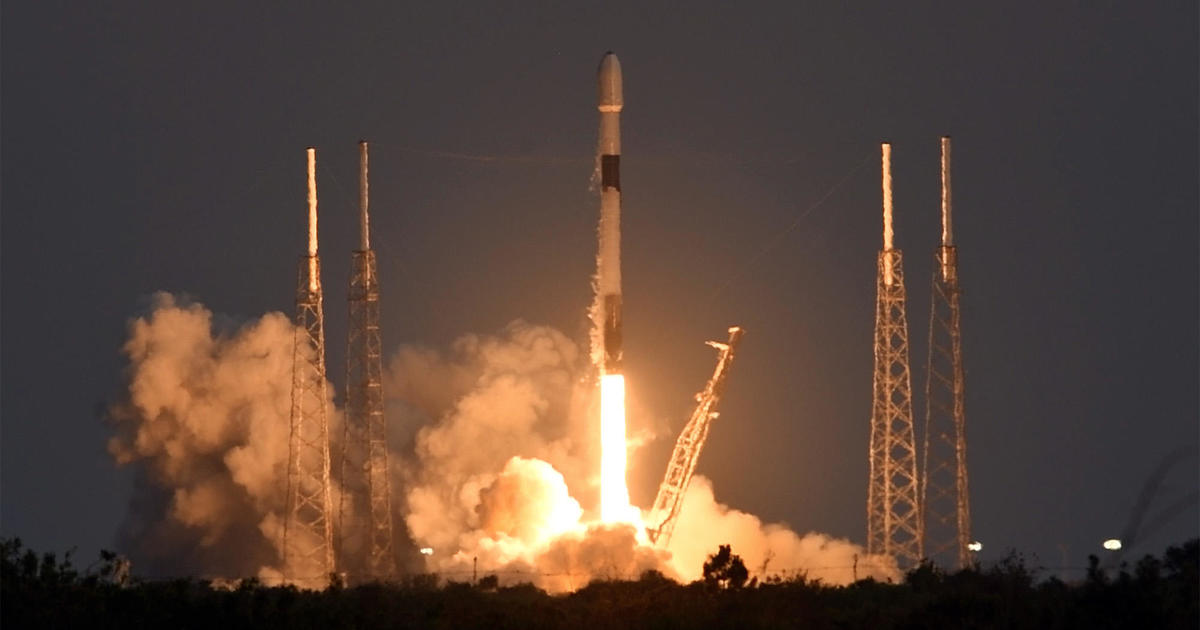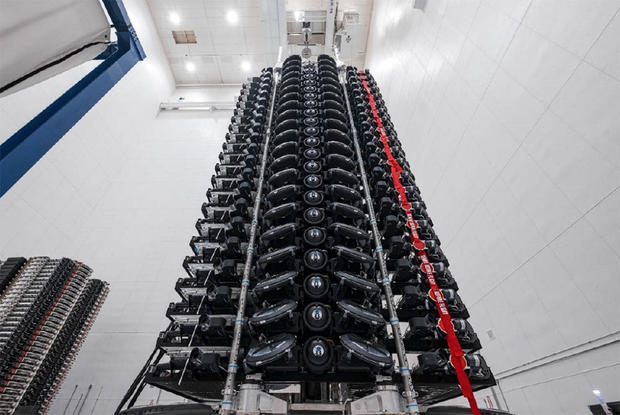SpaceX follows Crew Dragon launch scrub with successful Starlink flight

While working to fix a problem that derailed an attempt to launch a four-man crew to the International Space Station, SpaceX pressed ahead with the launch of another Falcon 9 rocket Monday, this one carrying 21 next-generation Starlink internet satellites.
The last-minute scrub of a Falcon 9 and Crew Dragon capsule at the Kennedy Space Center was caused by trouble with the rocket’s first-stage engine ignition system. To allow time to fix the problem, and to avoid expected bad weather Tuesday, another attempt to send the Crew Dragon fliers on their way was delayed to Thursday.
But that didn’t affect work at the nearby Cape Canaveral Space Force Station where a different SpaceX team counted down to launch of another Falcon 9 from pad 40. This time around, after a delay due to high levels of electrically charged solar wind particles, the countdown ticked smoothly to zero at 6:13 p.m. EST.
William Harwood/CBS News
Streaking away to the southeast a few minutes before sunset, the first stage boosted the vehicle out of the dense lower atmosphere in spectacular fashion before falling away and heading for landing on an offshore droneship.
The second stage continued the climb to orbit and one hour after liftoff, the 21 Starlinks were released to fly on their own in a 230-mile-high orbit that will carry them 43 degrees to either side of the equator. In that orbit, the satellites will fly over all points as far north as Boston and as far south as New Zealand.
The Starlink system is designed to deliver relatively high-speed internet to customers anywhere on Earth using thousands of broadband relay stations in multiple low-altitude orbits. The satellites maintain connections with customers using laser links to hand off data streams from one to another as they pass overhead.
Including Monday’s launch, SpaceX has now launched 4,002 Starlinks, “and is providing high-speed internet to more than one million locations around the world, the majority of which are households,” the company said in an online overview.
“Starlink continues to grow rapidly, and SpaceX has raced to keep up with a surging demand for connectivity across the globe, especially in areas where few, if any, options for broadband connections have existed before now.”
To meet that demand, the company is now building two versions of a larger, more powerful Starlink satellite. One that is intended to fly on the company’s planned Super Heavy/Starship rocket and a slightly smaller variant that can be carried aloft by the less powerful Falcon 9.
The Version 2, or V2, satellites launched on Falcon 9 “are a bit smaller, so we affectionately refer to them as ‘V2 Mini’ satellites,” SpaceX said. “But don’t let the name fool you, a V2 Mini satellite has four times the capacity for serving users compared to its earlier counterparts.”
SpaceX
SpaceX is one of several companies building space-based internet delivery systems, raising concerns about the possibility of malfunctions and debris-creating collisions threatening other spacecraft.
But SpaceX says its satellites are designed to operate in relatively low-altitude orbits that allow atmospheric drag to quickly deorbit spacecraft at the end of their lives or in case of disabling malfunctions, minimizing the threat of collisions.
The satellites can automatically change course to avoid potential close encounters with other spacecraft or debris and the company publishes detailed tracking data to give governments and other satellite operators detailed situational awareness.
One major issue associated with Starlinks and other planned “mega constellations” of space-based internet relay stations is their reflectivity and potential impact on ground-based optical and radio telescopes.
SpaceX said it is actively working with the astronomical community to develop mitigations, including advanced coatings and operational procedures designed to minimize the reflectivity of the V2 satellites.
“While our V2 Mini satellites are larger than earlier versions, we’re still expecting them to be as dark or darker once the full range of mitigations are implemented and the satellites reach their operational orbit,” SpaceX said.
“However, we want to emphasize that even though brightness component measurements, ground modeling and analysis show effective brightness mitigations, we won’t know the full efficacy of our efforts until on-orbit observations are made of the satellites and data is collected and analyzed.”
Share this news on your Fb,Twitter and Whatsapp
Times News Network:Latest News Headlines
Times News Network||Health||New York||USA News||Technology||World News


